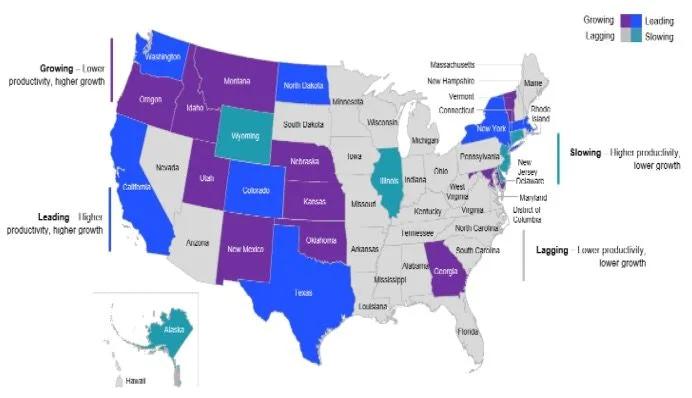
自2005年以来,劳动生产率增长一直低迷,平均每年增长1.4%,而二战后的平均水平为2.2%。
这是问题所在。提高劳动生产率——每单位投入的经济产出——可以保持美国的竞争力,提高人民的生活质量。提高劳动生产率在应对通胀、债务负担、应享权利和能源转型等挑战方面也至关重要。
到2030年,恢复历史上的劳动生产率增长速度可以为美国国内生产总值带来总计10万亿美元的收入,即在那一年每个美国家庭的家庭收入可以增加15200美元。
这并非易事——但在某些行业和地区,劳动生产率正在实现快速增长。自2007年以来,信息产业以每年5.5%的速度增长。北达科他州的经济增长率接近3.5%,华盛顿州的经济增长率为2.3%。我们需要更广泛地提高劳动生产率。
为了让美国的经济引擎发动起来,我们需要克服四大挑战。
劳动力短缺和技能缺口
有两大看似互不相关,实则相互关联的劳动力挑战。一是劳动力短缺。美国劳动力参与率从上世纪90年代末的67%降至62.3%。其中部分原因是人口老龄化:超过500万美国人没有工作,但表示他们想工作。
第二大挑战是,目前太多的劳动力不具备获得成功所需的技能。熟练人才对提高劳动生产率至关重要。在过去的30年里,对人才进行投资的公司获得了丰厚的回报。但重新培养技能是一个过程,而不是结果。随着技术的变化,人们需要掌握的技能也在变化。根据技能而不是证书来招聘——像一些州已经做的那样放弃学位要求——可以扩大合格人才的储备库。
数字化红利并未反馈到劳动生产率上
当数字化发挥作用时,数字化和劳动生产率之间的联系是密切的:从1989年到2019年,各行业的劳动生产率增长与其数字化水平之间存在很强的相关性。
例如,自2005年以来,信息、金融和批发贸易的劳动生产率都实现了快速增长,而且还实现了高度数字化。事态发展也有另一个朝向:建筑业是数字化程度第二低的行业,在过去的一代中几乎没有实现劳动生产率增长。数字化还有助于个别企业提高劳动生产率。以制造业为例,领先企业的劳动生产率是落后企业的五倍以上。
然而,许多投资数字化的公司并没有看到收益。我们从2022年开始的研究表明,大多数企业从数字化投资中获得的收益不到预期的三分之一。他们往往未能在战略、流程和培训方面做出必要的互补性改变,从而无法从数字化投资中实现全部价值。
领导者通过设定技术支持的大胆商业目标而脱颖而出。他们重新设计运营流程,而不是扩大现有的经营方式。也许最重要的是,他们没有忘记人为因素:他们支持个人和团队在这些新模式下开展高效合作。
无形资产投资不足
技术本身只是工具箱和字节:开发技术并将其投入使用需要在研究、知识产权和技术人员方面进行投资。
这样的支出创造了劳动生产率“J曲线”效应:最初的收益可能很小(甚至是负的),但长期价值是巨大的。但并不是所有的公司都会在第一时间进行投资。我们的研究发现,劳动生产率领先的公司在无形资产上的投资是前者的两倍多。
政府可以通过明确和简化监管规定,并放宽对新投资的限制来提高劳动生产率。
地理意义上的富国和穷国
威廉·吉布森(William Gibson)说:“未来已经到来,只是地区差异明显。美国国内的劳动生产率情况也是如此。在过去的一代中,一些州的表现远远高于平均水平。但太多州的劳动生产率低于平均水平,而且正在下滑。”
在各州内部,一些城市和地区发展也很落后。在这些地区,预期寿命较短等社会弊病往往比一般地区多。即使是劳动生产率高的城市,如旧金山,也未能做到收益平均分配。广泛地提高劳动生产率是一大社会问题,也是一大经济问题。
将美国的劳动生产率增长恢复到历史水平并非不可能。我们以前就做到过。从1980年到1995年,劳动生产率增长1.7%,然后在接下来的十年里加速到3%。
美国的当务之急是提高劳动生产率。我们需要提高劳动生产率来解决劳动力短缺问题、实现能源转型、提高收入、增强竞争力,以及提高所有美国人的生活水平。
阿苏托什·帕迪(Asutosh Padhi)是麦肯锡公司芝加哥办事处的高级合伙人和北美地区的管理合伙人。奥利维亚·怀特(Olivia White)是位于旧金山的麦肯锡全球研究所的负责人。(财富中文网)
译者:中慧言-王芳
美国各州劳动生产率表现不一(按州分类)。
自2005年以来,劳动生产率增长一直低迷,平均每年增长1.4%,而二战后的平均水平为2.2%。
这是问题所在。提高劳动生产率——每单位投入的经济产出——可以保持美国的竞争力,提高人民的生活质量。提高劳动生产率在应对通胀、债务负担、应享权利和能源转型等挑战方面也至关重要。
到2030年,恢复历史上的劳动生产率增长速度可以为美国国内生产总值带来总计10万亿美元的收入,即在那一年每个美国家庭的家庭收入可以增加15200美元。
这并非易事——但在某些行业和地区,劳动生产率正在实现快速增长。自2007年以来,信息产业以每年5.5%的速度增长。北达科他州的经济增长率接近3.5%,华盛顿州的经济增长率为2.3%。我们需要更广泛地提高劳动生产率。
为了让美国的经济引擎发动起来,我们需要克服四大挑战。
劳动力短缺和技能缺口
有两大看似互不相关,实则相互关联的劳动力挑战。一是劳动力短缺。美国劳动力参与率从上世纪90年代末的67%降至62.3%。其中部分原因是人口老龄化:超过500万美国人没有工作,但表示他们想工作。
第二大挑战是,目前太多的劳动力不具备获得成功所需的技能。熟练人才对提高劳动生产率至关重要。在过去的30年里,对人才进行投资的公司获得了丰厚的回报。但重新培养技能是一个过程,而不是结果。随着技术的变化,人们需要掌握的技能也在变化。根据技能而不是证书来招聘——像一些州已经做的那样放弃学位要求——可以扩大合格人才的储备库。
数字化红利并未反馈到劳动生产率上
当数字化发挥作用时,数字化和劳动生产率之间的联系是密切的:从1989年到2019年,各行业的劳动生产率增长与其数字化水平之间存在很强的相关性。
例如,自2005年以来,信息、金融和批发贸易的劳动生产率都实现了快速增长,而且还实现了高度数字化。事态发展也有另一个朝向:建筑业是数字化程度第二低的行业,在过去的一代中几乎没有实现劳动生产率增长。数字化还有助于个别企业提高劳动生产率。以制造业为例,领先企业的劳动生产率是落后企业的五倍以上。
然而,许多投资数字化的公司并没有看到收益。我们从2022年开始的研究表明,大多数企业从数字化投资中获得的收益不到预期的三分之一。他们往往未能在战略、流程和培训方面做出必要的互补性改变,从而无法从数字化投资中实现全部价值。
领导者通过设定技术支持的大胆商业目标而脱颖而出。他们重新设计运营流程,而不是扩大现有的经营方式。也许最重要的是,他们没有忘记人为因素:他们支持个人和团队在这些新模式下开展高效合作。
无形资产投资不足
技术本身只是工具箱和字节:开发技术并将其投入使用需要在研究、知识产权和技术人员方面进行投资。
这样的支出创造了劳动生产率“J曲线”效应:最初的收益可能很小(甚至是负的),但长期价值是巨大的。但并不是所有的公司都会在第一时间进行投资。我们的研究发现,劳动生产率领先的公司在无形资产上的投资是前者的两倍多。
政府可以通过明确和简化监管规定,并放宽对新投资的限制来提高劳动生产率。
地理意义上的富国和穷国
威廉·吉布森(William Gibson)说:“未来已经到来,只是地区差异明显。美国国内的劳动生产率情况也是如此。在过去的一代中,一些州的表现远远高于平均水平。但太多州的劳动生产率低于平均水平,而且正在下滑。”
在各州内部,一些城市和地区发展也很落后。在这些地区,预期寿命较短等社会弊病往往比一般地区多。即使是劳动生产率高的城市,如旧金山,也未能做到收益平均分配。广泛地提高劳动生产率是一大社会问题,也是一大经济问题。
将美国的劳动生产率增长恢复到历史水平并非不可能。我们以前就做到过。从1980年到1995年,劳动生产率增长1.7%,然后在接下来的十年里加速到3%。
美国的当务之急是提高劳动生产率。我们需要提高劳动生产率来解决劳动力短缺问题、实现能源转型、提高收入、增强竞争力,以及提高所有美国人的生活水平。
阿苏托什·帕迪(Asutosh Padhi)是麦肯锡公司芝加哥办事处的高级合伙人和北美地区的管理合伙人。奥利维亚·怀特(Olivia White)是位于旧金山的麦肯锡全球研究所的负责人。(财富中文网)
译者:中慧言-王芳
Since 2005, productivity growth has been lackluster, averaging 1.4% a year, compared to the post-World War II average of 2.2%.
That is a problem. Increasing productivity–economic output per unit of input–maintains U.S. competitiveness and improves our quality of life. It is also essential to meet challenges like inflation, debt loads, entitlements, and the energy transition.
Regaining historical rates of productivity growth could generate a total of $10 trillion for U.S. GDP by 2030, or $15,200 per U.S. household that year.
It won’t be easy–but productivity is growing fast in some sectors and geographies. Since 2007, the information sector has grown at 5.5% annually. North Dakota’s economy has grown at nearly 3.5% and Washington’s at 2.3%. We need to improve productivity more broadly.
To get the U.S. economic engine humming, we need to overcome four challenges.
Workforce shortages and skills gaps
There are two separate but linked workforce challenges. One is the lack of workers. U.S. workforce participation rate has fallen to 62.3%, down from 67% in the late 1990s. Only part of this is due to an aging population: More than 5 million Americans are not in the workforce but say they want to work.
The second challenge is that too many current workers do not have the skills they will need to succeed. Skilled talent is essential to productivity growth. In the last 30 years, firms that have invested in people have seen outsized returns. But re-skilling is a process, not a result. As technology changes, so do the skills people need. Hiring for skills rather than credentials–and dropping degree requirements as some states have done–could expand the qualified pool.
Digitization without a productivity dividend
When it works, the link between digitization and productivity is profound: From 1989 to 2019, there was a strong correlation between sectors’ productivity growth and their level of digitization.
Information, finance, and wholesale trade, for example, have all seen rapid productivity growth since 2005, and all are highly digitized. It goes in the other direction, too: the construction industry is the second-least digitalized sector, and has seen next to no productivity growth for a generation. Digitization also helps individual firms grow more productive. In manufacturing, for example, leading firms are more than five times as productive as the laggards.
However, many firms that have invested in digitization are not seeing the benefits. Our research from 2022 showed that most organizations achieved less than a third of the impact they expected from digital investments. Too often, they fail to make the complementary changes across strategy, processes, and training needed to extract full value from digitization.
Leaders distinguish themselves by setting bold business goals enabled by technology. They redesign operational processes rather than augment existing ways of doing business. And perhaps most importantly, they don’t forget the human element: They support individuals and teams to work together effectively in these new models.
Underinvestment in intangibles
Technology by itself is just boxes and bytes: developing it and then putting it to work requires investments in research, intellectual property, and skilled people.
Such expenditure creates a productivity “J-curve” in which the initial benefits may be small (or even negative) but long-term value is substantial. But not all firms invest in the first place. Our research has found that productivity-leading firms invest more than twice as much in intangibles.
Government has a role to play, too, by clarifying and simplifying regulations, and easing constraints on new investments.
Geographic haves and have nots
“The future is already here–it’s just not evenly distributed,” noted William Gibson. And that is true for U.S. productivity. Some states have performed well above average over the last generation. But too many others have below-average productivity and are slipping.
Within states, too, some cities and regions have fallen behind. Such areas often see more than their share of social ills such as lower life expectancy. Even cities with high productivity, such as San Francisco, have not succeeded in distributing gains evenly. Broadly improving productivity is a social as well as an economic issue.
Restoring U.S. productivity growth to its historical rate is not impossible. We’ve done it before. From 1980 to 95, productivity growth was at 1.7%, then accelerated to 3% for the next decade.
Revving up U.S. productivity should be seen a national imperative. We need it to address workforce shortages, manage the energy transition, raise incomes, improve competitiveness–and enhance the lives of all Americans.
Asutosh Padhi is a senior partner in McKinsey & Company’s Chicago office and managing partner for North America. Olivia White is a director of the McKinsey Global Institute in San Francisco.






